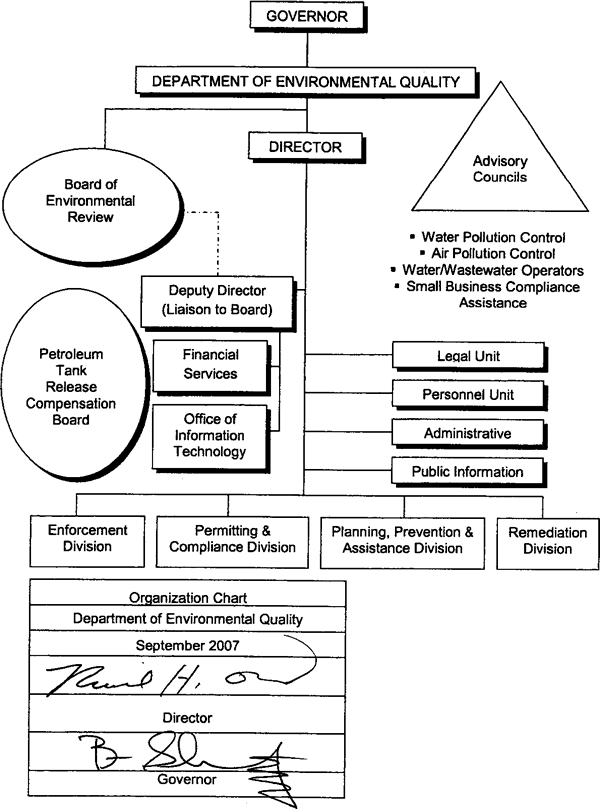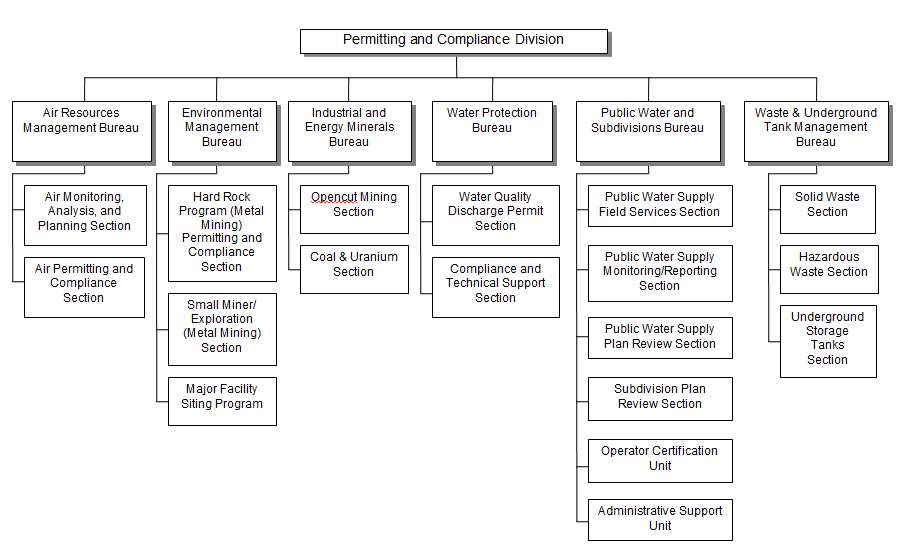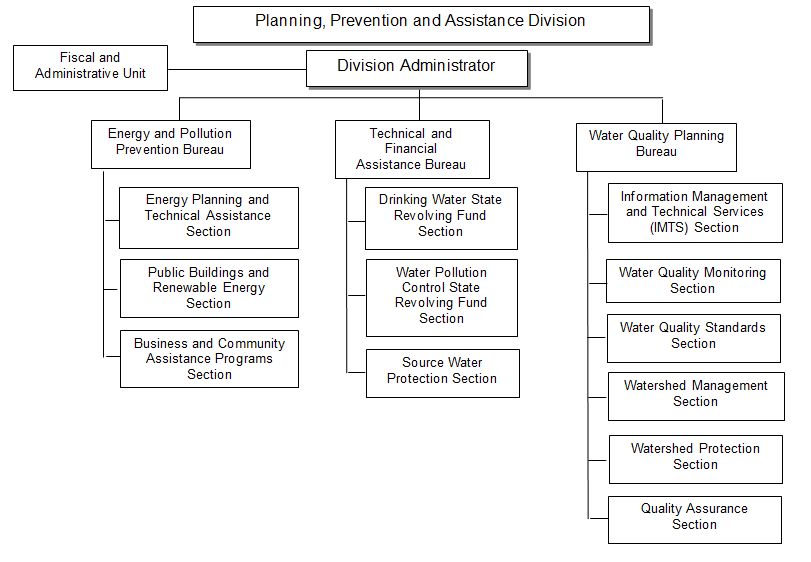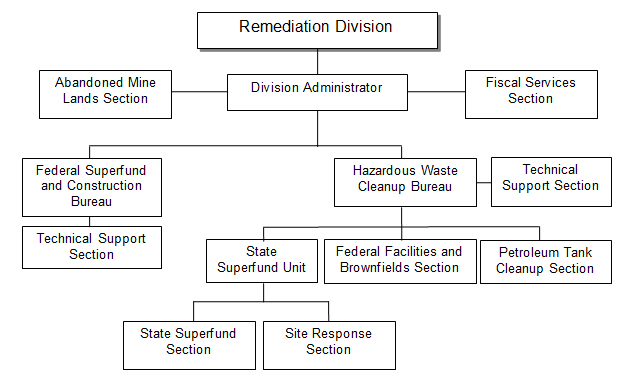
| HOME | SEARCH | ABOUT US | CONTACT US | HELP | ||
| |
| This is an obsolete version of the rule. Please click on the rule number to view the current version. |
|
17.1.101 ORGANIZATION OF DEPARTMENT (1) History and Purpose. The Department of Environmental Quality was created by Chapter 418, Laws of 1995. It administers most of Montana's environmental regulatory, environmental cleanup, environmental monitoring, pollution prevention, and energy conservation laws. (2) Organization. The department is headed by the director, who is appointed by the Governor. Within the director's office are a deputy director and three work units that report directly to the director. These work units are the Legal Unit, the Personnel Unit, and the Montana Environmental Policy Act Unit. The offices of financial services and information technology report to the deputy director. Below the director's office the department is divided into four divisions, each of which is headed by an administrator. Three divisions are divided into bureaus, each of which is headed by a chief. One board is attached to the department for administrative purposes only as provided in 2-15-121, MCA. Another board appears in these rules because the department provides it with budgeting and technical support. Both boards exercise rulemaking and adjudicatory functions. Four advisory councils advise the department and one of the boards. Advisory councils do not have any rulemaking or adjudicatory function. They have advisory roles only. (3) Department Organizational Units. The organizational structure and allocation of functions is as follows: (a) Director's Office. The director is responsible for the administration of all the functions vested by law in the department and for establishing policy to be followed by the department. In addition, the work units in the director's office provide legal, personnel, communications, and environmental impact statement preparation services to the director and the divisions within the agency. (b) Planning, Prevention, and Assistance Division. This division performs planning, pollution prevention, energy conservation, financing assistance, and environmental monitoring functions. It is divided into the following bureaus: (i) Energy and Pollution Prevention Bureau. This bureau conducts inventories of pollution sources, provides small business assistance, public education, and research and development activities to prevent air and water pollution and to promote energy conservation, the use of alternative and renewable energy sources and the reduction, reuse, recycling, and composting of wastes. This bureau also provides energy retrofits to hospitals and public buildings and technical assistance regarding energy efficiency, indoor air quality, and radon in public and commercial facilities. (ii) Water Quality Planning Bureau. This bureau provides planning for the management of watersheds, supports statewide water quality monitoring networks, conducts inventories of pollution sources, identifies impaired streams and lakes, and maintains statewide environmental monitoring databases. The bureau also oversees the development of water quality standards and total maximum daily load (TMDL) plans. (iii) Technical and Financial Assistance Bureau. This bureau operates the drinking water revolving and water pollution control revolving funds that provide loans to communities for the construction and improvement of drinking water and wastewater systems. The bureau also oversees the source water protection program and assesses the susceptibility of public water supplies to potential contaminants. (c) Permitting and Compliance Division. This division administers the department's air quality, water quality, public water supply and public sewage system, sanitation in subdivisions, solid waste, junk vehicle, hazardous waste, asbestos control, water and wastewater operator, septic tank and privy cleaner, underground storage tank operator, mine, and facility permitting statutes. This division also prepares environmental assessments in connection with these permitting activities. The division is divided into the following bureaus: (i) Air Resources Management Bureau. This bureau regulates air quality by issuing air quality permits; inspecting and providing compliance assistance for air emission sources; issuing permits for open burning activities; developing state implementation plans to ensure compliance with state and federal air quality standards; and administering air quality monitoring and assessment programs. (ii) Industrial and Energy Minerals Bureau. This bureau permits and regulates prospecting and mining of coal and uranium, and mining of sand, gravel, bentonite, scoria, peat, soil, and clay. (iii) Environmental Management Bureau. This bureau permits and regulates exploration for and mining of metal ores and other materials such as talc, limestone, and building stone under the Metal Mine Reclamation Act. It also administers the Major Facility Siting Act, including the permitting and regulation of major transmission lines and pipelines. (iv) Waste and Underground Tank Management Bureau. This bureau permits and regulates landfills and other solid waste facilities, motor vehicle wrecking facilities and graveyards, cesspool, septic tank, privy cleaners, hazardous waste, and asbestos. It implements the underground storage tank leak prevention program, including the permitting of underground storage tank installations, and the methamphetamine cleanup program. (v) Water Protection Bureau. This bureau permits and regulates the discharge of wastewater, storm water, and other wastes into surface water and ground water. (vi) Public Water Supply and Subdivisions Bureau. This bureau reviews and regulates public drinking water systems, public wastewater systems, and the sanitary and storm drainage features of subdivisions. It assures that the design and monitoring of public water systems and the design of public wastewater systems comply with the requirements. It provides training and certifies operators of public drinking water systems and wastewater treatment plants and confirms that proposed subdivisions meet the minimum standards. (d) Enforcement Division. This division develops enforcement policies and conducts enforcement activities to obtain compliance with permitting and regulatory statutes. It also accepts and investigates citizen complaints. (e) Remediation Division. This division oversees and conducts investigation and cleanup activities at state and federal superfund sites; voluntary cleanup activities; reclaims abandoned mine lands; implements corrective actions at sites with leaking underground storage tanks; and oversees ground water remediation at sites where improper placement of wastes has caused ground water contamination. It also administers provisions of the federal Comprehensive Environmental Response and Liability Act (CERCLA) and the state Comprehensive Environmental Cleanup and Responsibility Act (CECRA). This division is divided into the following bureaus: (i) Hazardous Waste Cleanup Bureau. This bureau oversees or conducts the investigation and cleanup of sites contaminated by chemical spills, hazardous substances and petroleum released by industrial and commercial operations. This bureau administers department actions under CECRA The bureau provides grants to local governments for compliance assistance. (ii) Federal Superfund and Construction Bureau. This bureau is responsible for administering and overseeing remedial actions conducted by the department under CERCLA. (4) Boards. (a) Board of Environmental Review. This board, which is appointed by the Governor, consists of seven members with expertise in health, hydrology, local government planning, environmental sciences, and law. The board adopts rules and determines appeals under some of the regulatory statutes administered by the department. (b) Petroleum Tank Release Compensation Board. This board administers the petroleum tank release cleanup fund. The board, which is appointed by the Governor, consists of seven members consisting of representatives from the financial or banking industry, small business, environmental law, various petroleum industries, the petroleum release remediation consulting industry, the insurance industry, and the general public. The board determines eligibility of owners and operators of petroleum tanks from which there has been a release and reimburses eligible owners and operators for a portion of their corrective action costs. (5) Advisory Councils. The following advisory councils are created by statute: (a) Air Pollution Control Advisory Council. This council provides advice to the department in matters related to air pollution. (b) Small Business Compliance Assistance Advisory Council. This body advises the department on small business stationary sources and consults with small business stationary sources concerning implementation and application of the requirements of the technical and environmental compliance assistance program. (c) Water Pollution Control Advisory Council. This council advises the department on matters related to water pollution and the adoption of rules under the Water Quality Act. (d) Water and Wastewater Operators' Advisory Council. This council advises and assists the department in the administration of its program for certification of water and wastewater treatment plant operations. (6) Information and Submissions. General inquiries regarding the department, boards, or advisory councils may be addressed to the director. Specific inquiries regarding the functions of a division may be addressed to the administrator of that division. All requests for department policy, hearings, declaratory rulings, and participation in rulemaking should be addressed to the director unless the notice in the Montana Administrative Register makes specific provisions for submissions. (7) Personnel Roster. Following are addresses of key officials of the Department of Environmental Quality and boards. If no address is given after the name, that official can be reached by writing to the Department of Environmental Quality, 1520 E. Sixth Avenue, P.O. Box 200901, Helena, Montana 59620-0901 or phoning (406) 444-2544. (a) Department officials. (i) Director (ii) Deputy Director (iii) Personnel Officer (iv) Chief Legal Counsel (v) Chief Financial Officer (vi) Chief Information Officer (vii) Administrator, Permitting and Compliance Division (viii) Administrator, Planning, Prevention, and Assistance Division (ix) Administrator, Remediation Division, 1100 Last Chance Gulch, P.O. Box 200901, Helena, Montana 59601 (x) Administrator, Enforcement Division (b) Board chairpersons. (i) Chairperson, Petroleum Tank Release Compensation Board, 1100 Last Chance Gulch, P.O. Box 200902, Helena, Montana 59601 (ii) Chairperson, Board of Environmental Review (8) Charts of Agency Organization. Descriptive charts of the Department of Environmental Quality follow.
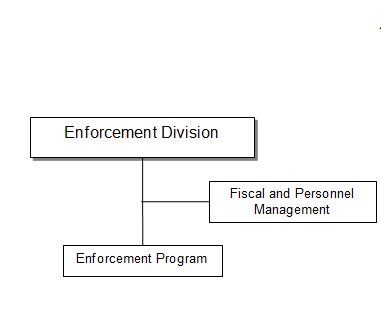
History: 2-4-201, MCA; IMP, 2-4-201, MCA; NEW, Eff. 9/30/98; AMD, Eff. 7/1/00; AMD, Eff. 3/1/04; AMD, Eff. 3/31/05; AMD, Eff. 9/30/07; AMD, Eff. 12/31/07; AMD, Eff. 3/31/14. |
A directory of state agencies is available online at http://www.mt.gov/govt/agencylisting.asp.
For questions about the organization of the ARM or this web site, contact sosarm@mt.gov.
